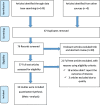The impact of being of the female gender for household head on the prevalence of food insecurity in Ethiopia: a systematic-review and meta-analysis
- PMID: 32518705
- PMCID: PMC7275294
- DOI: 10.1186/s40985-020-00131-8
The impact of being of the female gender for household head on the prevalence of food insecurity in Ethiopia: a systematic-review and meta-analysis
Abstract
Background: Ethiopia signed both for Millennium Development Goals (MDGs) previously and Sustainable Development Goals (SDGs) currently to improve food security through gender equality and empowerment of women by positioning them as household leader. However, there is no concrete evidence about the impact of being of the female gender for household head on the prevalence of food insecurity at the national level, the authors' intention being to fill this gap.
Methods: Preferred Reporting Items for Systematic Reviews and Meta-Analyses protocol (PRISMA-P) guideline was followed. All major databases such as PubMed/MEDLINE, WHOLIS, Cochrane Library, Embase, PsycINFO, ScienceDirect, Web of science, and reference lists were used to identify published articles, whereas shelves, author contact, Google, and Google Scholar were also searched to identify unpublished studies. Joanna Briggs Institute Meta-Analysis of Statistical Assessment and Review Instrument (JBI-MAStARI) was used for critical appraisal of studies. Meta-analysis was conducted using the STATA software version 14. The random effect model was used to estimate the pooled prevalence of food insecurity at 95% confidence level, while subgroup analysis and meta-regression were employed to identify the possible source of heterogeneity and the associated factors respectively. Moreover, Begg's test was used to check publication bias.
Results: A total of 143 articles were identified, of which 15 studies were included in the final model with a total sample size of 2084 female-headed households. The pooled estimate of food insecurity among female-headed households was 66.11% (95% confidence level (CL) 54.61, 77.60). Female-headed households had 1.94 (95% CL 1.26, 3.01) times the odds of developing food insecurity as compared with male-headed households in Ethiopia. However, considerable heterogeneity across studies was also exhibited (I 2 = 92.5%, p value < 0.001).
Conclusion: This review found that severity of food insecurity among female-headed households in Ethiopia was a more pronounced issue as compared with the general national estimate of food insecurity. Food insecurity among them was two-fold increased as compared with their men counterparts.So that, the government of Ethiopia needs to outlook how cultural and social restriction of women's involvement in every aspect of activity affects their level of household food security. Beyond this, previous success and current gap of food insecurity among female-headed households should be explored in future research to run in accordance with Sustainable Development Goals (SDGs) specially with goals 2 and 5.
Keywords: Ethiopia; Female-headed households; Food insecurity; Meta-analysis; Systematic review.
© The Author(s) 2020.
Conflict of interest statement
Competing interestsThe authors have declared that there is no competing interest.
Figures



References
-
- Katherine A. Briefel Ronette R, and Frongillo Jr Edward A et al: Food insufficiency exists in the United States: results from the third National Health and Nutrition Examination Survey (NHANES III) American Journal of Public Health. 1998;88(3):419–426. doi: 10.2105/AJPH.88.3.419. - DOI - PMC - PubMed
-
- Campbell Cathy C. and Desjardins Ellen: A model and research approach for studying the management of limited food resources by low income families. Journal of Nutrition Education. 1989;21(4):162–171. doi: 10.1016/S0022-3182(89)80052-4. - DOI
-
- Food and Agricalture Organization: Measurement and assessment of food deprivation and undernutrition [cited 2007 Feb 22.
-
- Coates Jennifer, Swindale Anne, and Bilinsky Paula: Household Food Insecurity Access Scale (HFIAS) for measurement of food access: indicator guide: version 3. 2007.
-
- FANTA III, USAID, and Tufts university: A guide for Household hunger scale (HHS) August, 2011.
Publication types
LinkOut - more resources
Full Text Sources
Miscellaneous

